2005 RENAULT MEGANE engine
[x] Cancel search: enginePage 33 of 250
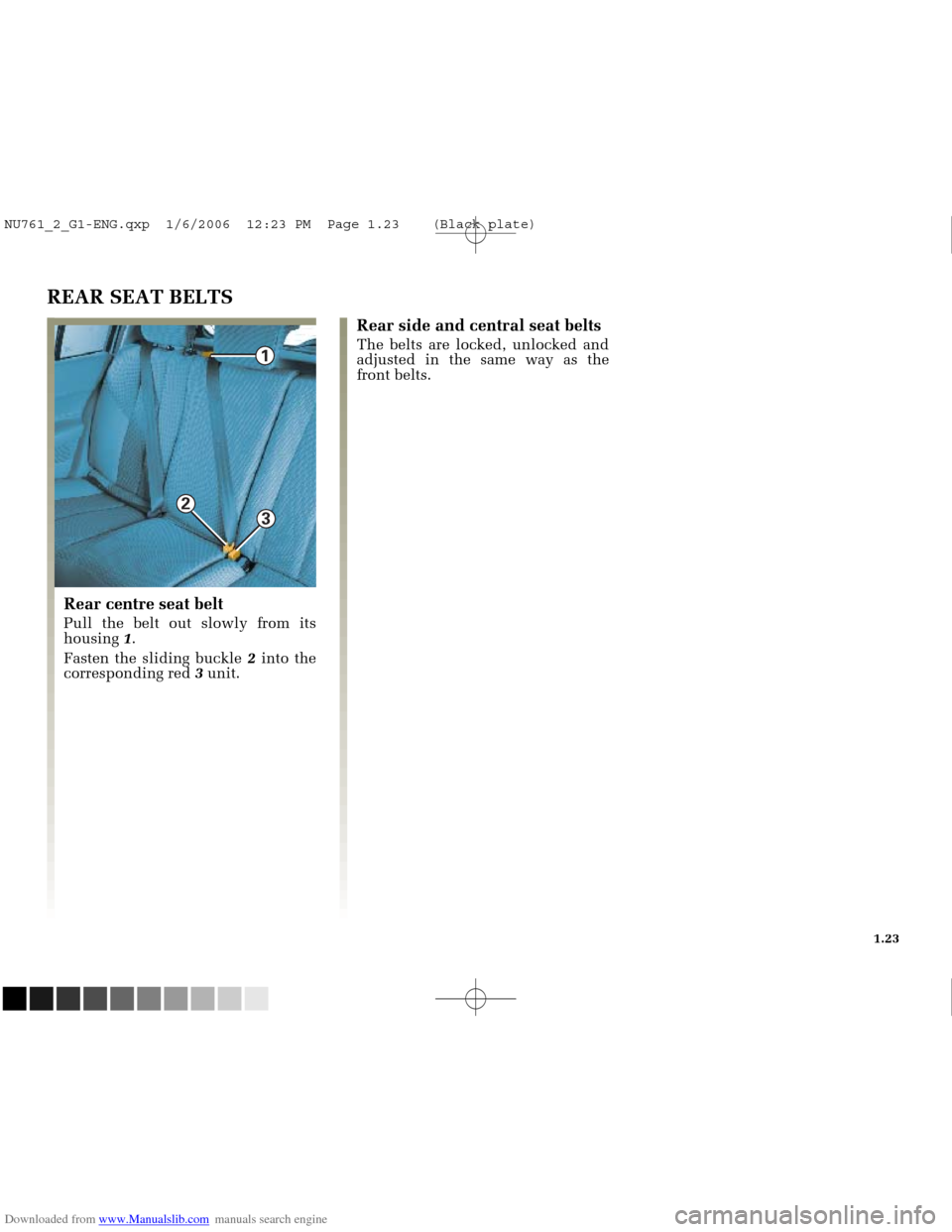
Downloaded from www.Manualslib.com manuals search engine
3
1
2
NU761_2_G1-FRA.qxd 10/11/05 15:53 Page 1.23
1.23
REAR SEAT BELTS
Rear centre seat belt
Pull the belt out slowly from its
housing 1.
Fasten the sliding buckle 2into the
corresponding red 3unit.
Rear side and central seat belts
The belts are locked, unlocked and
adjusted in the same way as the
front belts.
NU761_2_G1-ENG.qxp 1/6/2006 12:23 PM Page 1.23 (Black plate)
Page 34 of 250
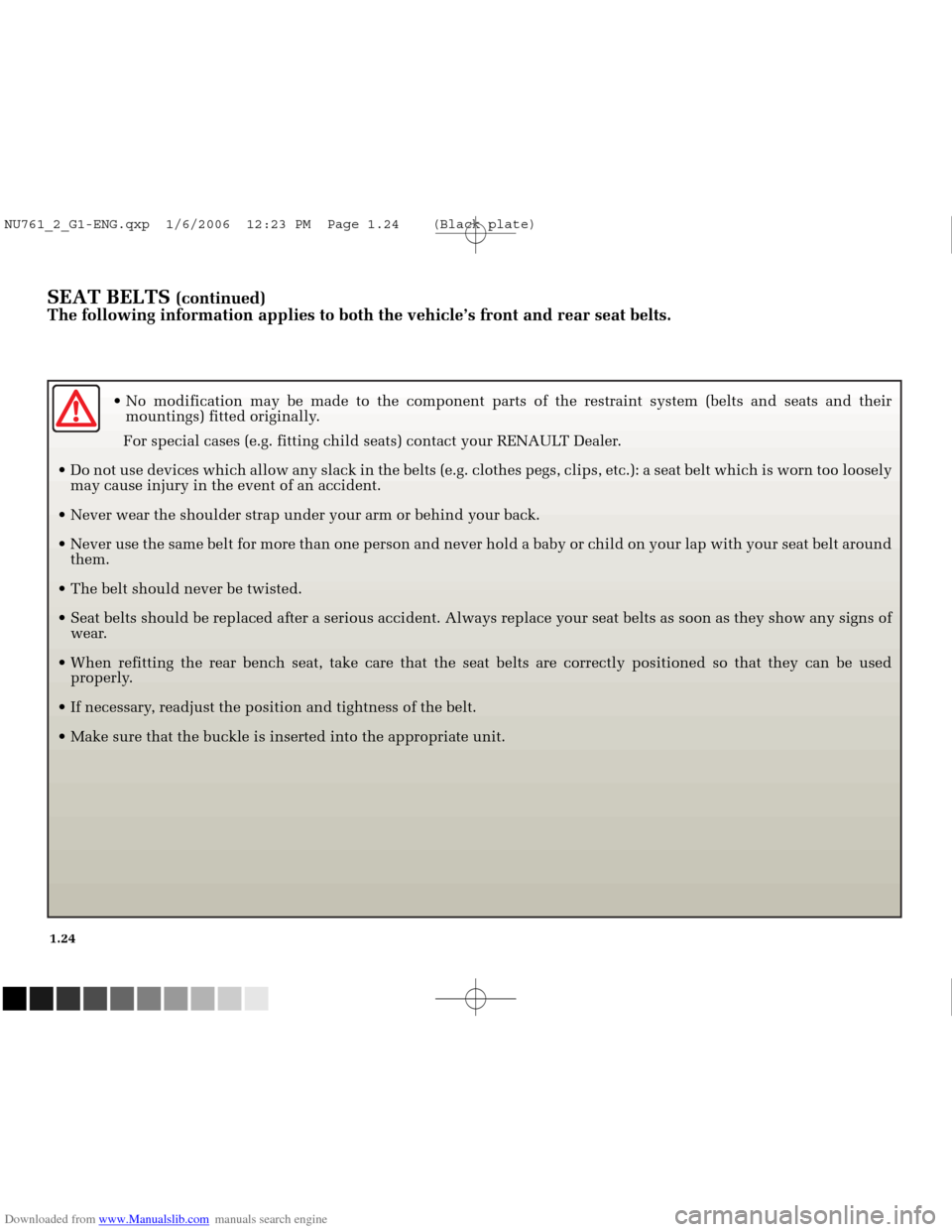
Downloaded from www.Manualslib.com manuals search engine
NU761_2_G1-FRA.qxd 10/11/05 15:53 Page 1.24
1.24
SEAT BELTS (continued)
The following information applies to both the vehicle’s front and rea\
r seat belts.
No modification may be made to the component parts of the restraint syst\
em (belts and seats and their mountings) fitted originally.
For special cases (e.g. fitting child seats) contact your RENAULT Dealer.
Do not use devices which allow any slack in the belts (e.g. clothes peg\
s, clips, etc.): a seat belt which is worn too loosely may cause injury in the event of an accident.
Never wear the shoulder strap under your arm or behind your back.
Never use the same belt for more than one person and never hold a baby o\
r child on your lap with your seat belt around them.
The belt should never be twisted.
Seat belts should be replaced after a serious accident. Always replace y\
our seat belts as soon as they show any signs of wear.
When refitting the rear bench seat, take care that the seat belts are co\
rrectly positioned so that they can be used properly.
If necessary, readjust the position and tightness of the belt.
Make sure that the buckle is inserted into the appropriate unit.
NU761_2_G1-ENG.qxp 1/6/2006 12:23 PM Page 1.24 (Black plate)
Page 35 of 250
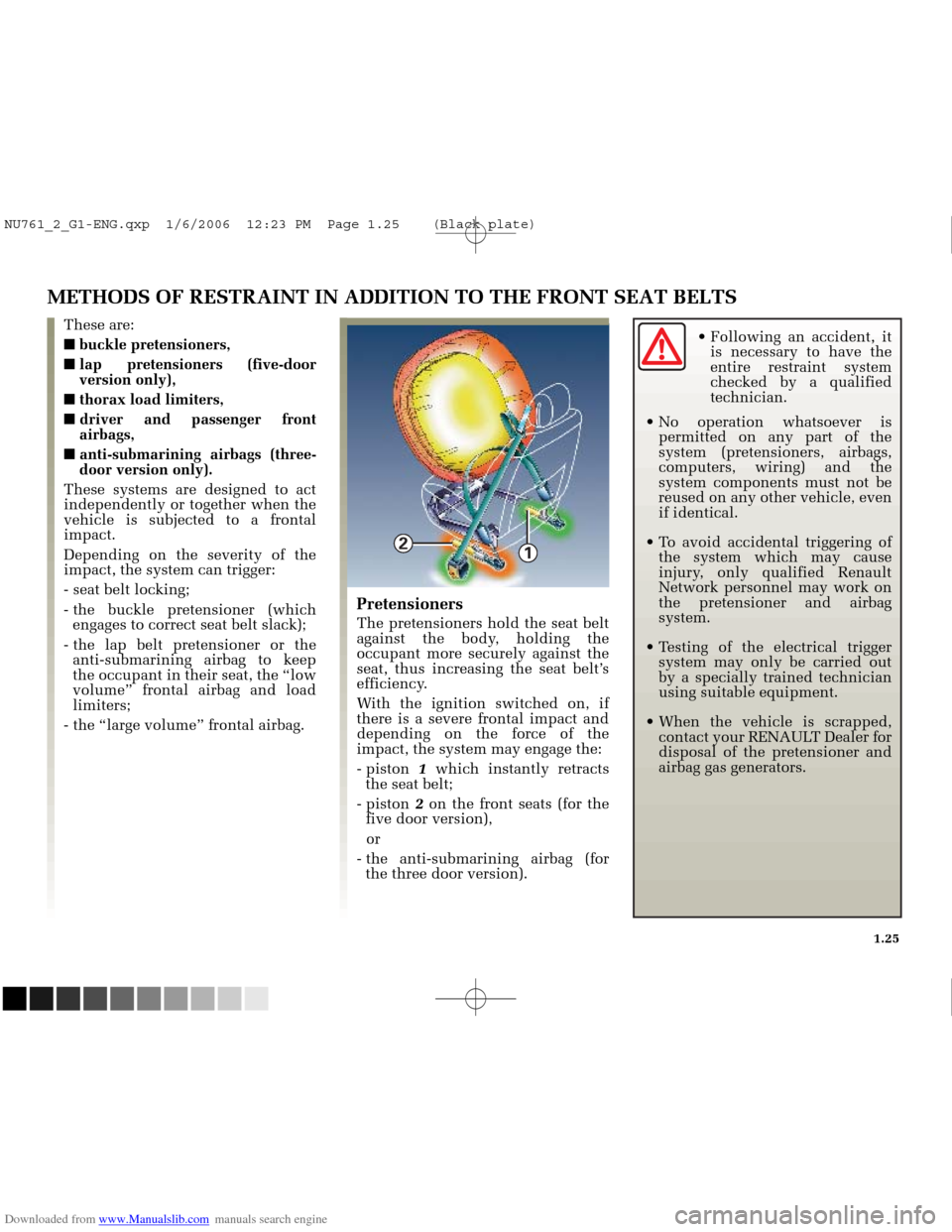
Downloaded from www.Manualslib.com manuals search engine
2
1
NU761_2_G1-FRA.qxd 10/11/05 15:53 Page 1.25
1.25
Following an accident, itis necessary to have the
entire restraint system
checked by a qualified
technician.
No operation whatsoever is permitted on any part of the
system (pretensioners, airbags,
computers, wiring) and the
system components must not be
reused on any other vehicle, even
if identical.
To avoid accidental triggering of the system which may cause
injury, only qualified Renault
Network personnel may work on
the pretensioner and airbag
system.
Testing of the electrical trigger system may only be carried out
by a specially trained technician
using suitable equipment.
When the vehicle is scrapped, contact your RENAULT Dealer for
disposal of the pretensioner and
airbag gas generators.
METHODS OF RESTRAINT IN ADDITION TO THE FRONT SEAT BELTS
These are:
■ buckle pretensioners,
■ lap pretensioners (five-door
version only),
■ thorax load limiters,
■ driver and passenger front
airbags,
■ anti-submarining airbags (three-
door version only).
These systems are designed to act
independently or together when the
vehicle is subjected to a frontal
impact.
Depending on the severity of the
impact, the system can trigger:
- seat belt locking;
- the buckle pretensioner (which engages to correct seat belt slack);
- the lap belt pretensioner or the anti-submarining airbag to keep
the occupant in their seat, the “low
volume” frontal airbag and load
limiters;
- the “large volume” frontal airbag.
Pretensioners
The pretensioners hold the seat belt
against the body, holding the
occupant more securely against the
seat, thus increasing the seat belt’s
efficiency.
With the ignition switched on, if
there is a severe frontal impact and
depending on the force of the
impact, the system may engage the:
- piston 1which instantly retracts
the seat belt;
- piston 2on the front seats (for the
five door version),
or
- the anti-submarining airbag (for the three door version).
NU761_2_G1-ENG.qxp 1/6/2006 12:23 PM Page 1.25 (Black plate)
Page 36 of 250

Downloaded from www.Manualslib.com manuals search engine
A
NU761_2_G1-FRA.qxd 10/11/05 15:53 Page 1.26
1.26
METHODS OF RESTRAINT IN ADDITION TO THE FRONT SEAT BELTS (continued)
Load limiter
Above a certain severity of impact,
this mechanism is used to limit the
force of the belt against the body so
that it is at an acceptable level.
Driver and passenger airbags
Fitted to the driver and passenger
side.
The word “Airbag” on the steering
wheel and the dashboard (airbag
zone A) and an airbag marking in the
lower section of the windscreen
indicate the presence of this
equipment.
Each airbag system consists of:
- an airbag and gas generator fitted on the steering wheel for the driver
and in the dashboard for the front
passenger;
- an intelligent computer for both systems, which includes an impact
sensor and a monitor controlling
the electrical trigger system for the
gas generator;
- a single
åwarning light on the
instrument panel;
- an advanced frontal sensor completes this system. The airbag system uses the
principles of pyrotechnics. This
explains why, when the airbag
inflates, it will generate heat,
produce smoke (this does not mean
that a fire is about to start) and
make a noise upon detonation. In a
situation where an airbag is
required, it will inflate immediately
and this may cause some minor,
superficial grazing to the skin or
other problems.
NU761_2_G1-ENG.qxp 1/6/2006 12:23 PM Page 1.26 (Black plate)
Page 37 of 250
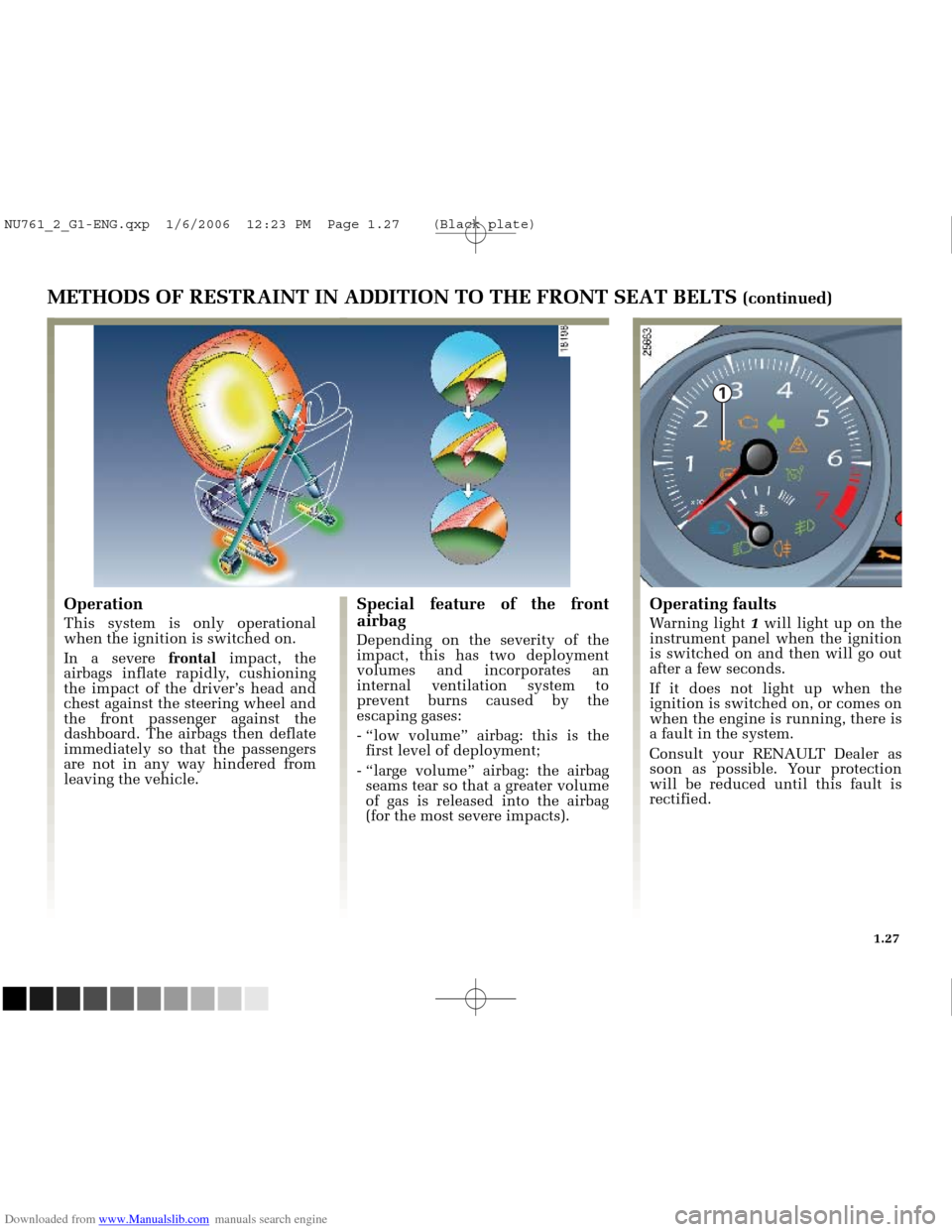
Downloaded from www.Manualslib.com manuals search engine
1
NU761_2_G1-FRA.qxd 10/11/05 15:53 Page 1.27
1.27
METHODS OF RESTRAINT IN ADDITION TO THE FRONT SEAT BELTS (continued)
Operation
This system is only operational
when the ignition is switched on.
In a severe frontalimpact, the
airbags inflate rapidly, cushioning
the impact of the driver’s head and
chest against the steering wheel and
the front passenger against the
dashboard. The airbags then deflate
immediately so that the passengers
are not in any way hindered from
leaving the vehicle.
Special feature of the front
airbag
Depending on the severity of the
impact, this has two deployment
volumes and incorporates an
internal ventilation system to
prevent burns caused by the
escaping gases:
- “low volume” airbag: this is the first level of deployment;
- “large volume” airbag: the airbag seams tear so that a greater volume
of gas is released into the airbag
(for the most severe impacts).
Operating faults
Warning light 1will light up on the
instrument panel when the ignition
is switched on and then will go out
after a few seconds.
If it does not light up when the
ignition is switched on, or comes on
when the engine is running, there is
a fault in the system.
Consult your RENAULT Dealer as
soon as possible. Your protection
will be reduced until this fault is
rectified.
NU761_2_G1-ENG.qxp 1/6/2006 12:23 PM Page 1.27 (Black plate)
Page 38 of 250
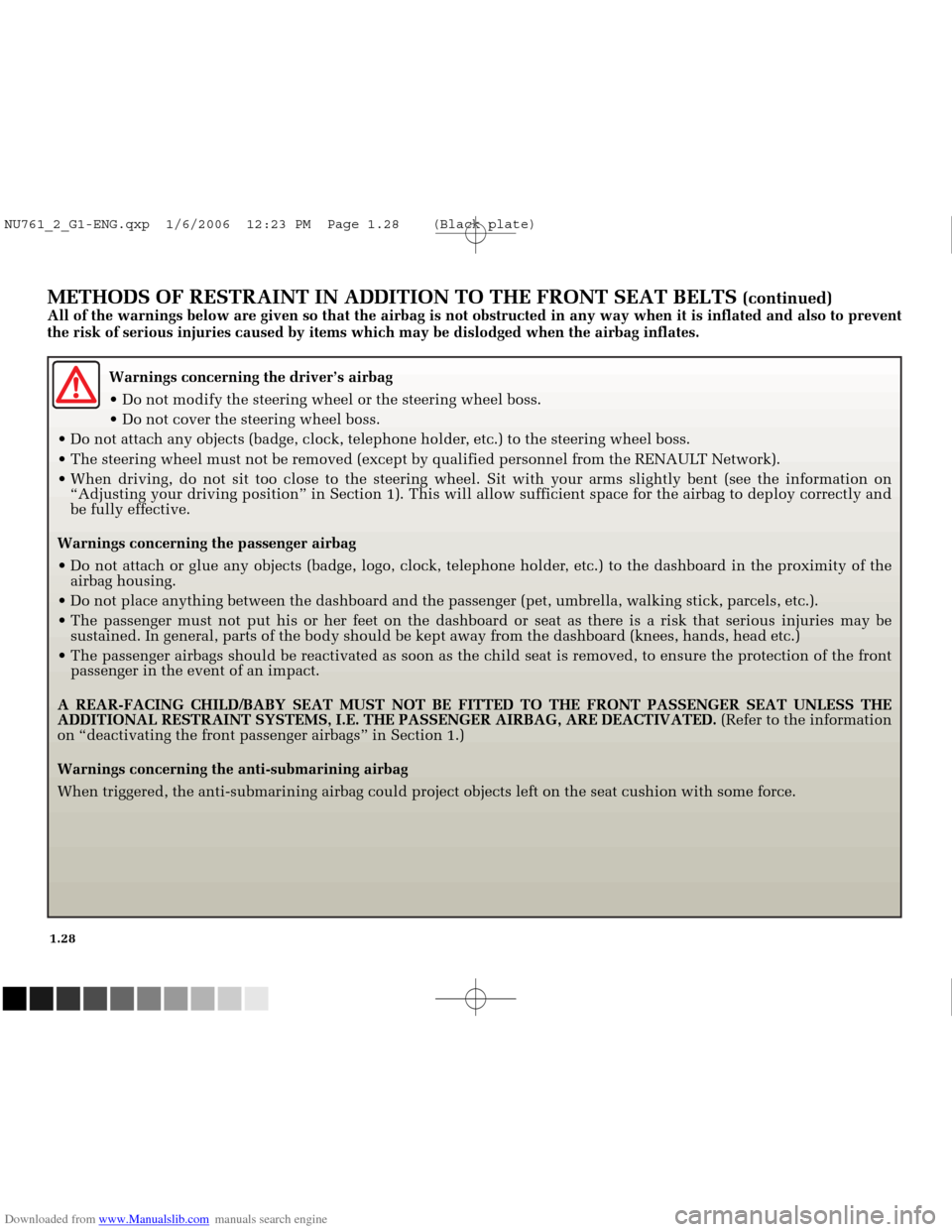
Downloaded from www.Manualslib.com manuals search engine
NU761_2_G1-FRA.qxd 10/11/05 15:53 Page 1.28
1.28
METHODS OF RESTRAINT IN ADDITION TO THE FRONT SEAT BELTS (continued)All of the warnings below are given so that the airbag is not obstructed\
in any way when it is inflated and also to prevent
the risk of serious injuries caused by items which may be dislodged when\
the airbag inflates.Warnings concerning the driver’s airbag
Do not modify the steering wheel or the steering wheel boss.
Do not cover the steering wheel boss.
Do not attach any objects (badge, clock, telephone holder, etc.) to the steering wheel boss.
The steering wheel must not be removed (except by qualified personnel\
from the RENAULT Network).
When driving, do not sit too close to the steering wheel. Sit with your \
arms slightly bent (see the information on “Adjusting your driving position” in Section 1). This will allow \
sufficient space for the airbag to deploy correctly and
be fully effective.
Warnings concerning the passenger airbag
Do not attach or glue any objects (badge, logo, clock, telephone holder\
, etc.) to the dashboard in the proximity of the airbag housing.
Do not place anything between the dashboard and the passenger (pet, umb\
rella, walking stick, parcels, etc.).
The passenger must not put his or her feet on the dashboard or seat as t\
here is a risk that serious injuries may be sustained. In general, parts of the body should be kept away from the da\
shboard (knees, hands, head etc.)
The passenger airbags should be reactivated as soon as the child seat is\
removed, to ensure the protection of the front passenger in the event of an impact.
A REAR-FACING CHILD/BABY SEAT MUST NOT BE FITTED TO THE FRONT PASSENGER \
SEAT UNLESS THE
ADDITIONAL RESTRAINT SYSTEMS, I.E. THE PASSENGER AIRBAG, ARE DEACTIVATED\
. (Refer to the information
on “deactivating the front passenger airbags” in Section 1.)
Warnings concerning the anti-submarining airbag
When triggered, the anti-submarining airbag could project objects left o\
n the seat cushion with some force.
NU761_2_G1-ENG.qxp 1/6/2006 12:23 PM Page 1.28 (Black plate)
Page 39 of 250

Downloaded from www.Manualslib.com manuals search engine
NU761_2_G1-FRA.qxd 10/11/05 15:53 Page 1.29
1.29
Following an accident, itis necessary to have the
entire restraint system
checked by a qualified
technician.
No operation whatsoever is permitted on any part of the
system (pretensioners, airbags,
computers, wiring) and the
system components must not be
reused on any other vehicle, even
if identical.
To avoid accidental triggering of the system which may cause
injury, only qualified RENAULT
Network personnel may work on
the pretensioner and airbag
system.
Testing of the electrical trigger system may only be carried out
by a specially trained technician
using suitable equipment.
When the vehicle is scrapped, contact your RENAULT Dealer for
disposal of the pretensioner and
airbag gas generators.
METHODS OF RESTRAINT IN ADDITION TO THE REAR SEAT BELTS
Depending on the vehicle, they
comprise:
■ seat belt pretensioners built into
the inertia reels,
■ load limiter.
These systems are designed to act
independently or together when the
vehicle is subjected to a frontal
impact.
There are two possibilities,
depending on the force of the
impact:
- protection is provided by the belt only;
- the pretensioner is triggered to rectify seat belt slack.
Rear seat belt pretensioners
This system is only operational
when the ignition is switched on.
If the vehicle is subjected to a severe
frontal impact, a device retracts the
seat belt, pulling the seat belt tight
against the body and thus improving
its effectiveness.
Load limiter
Above a certain severity of impact,
this mechanism is used to limit the
force of the belt against the body so
that it is at an acceptable level.
NU761_2_G1-ENG.qxp 1/6/2006 12:23 PM Page 1.29 (Black plate)
Page 40 of 250
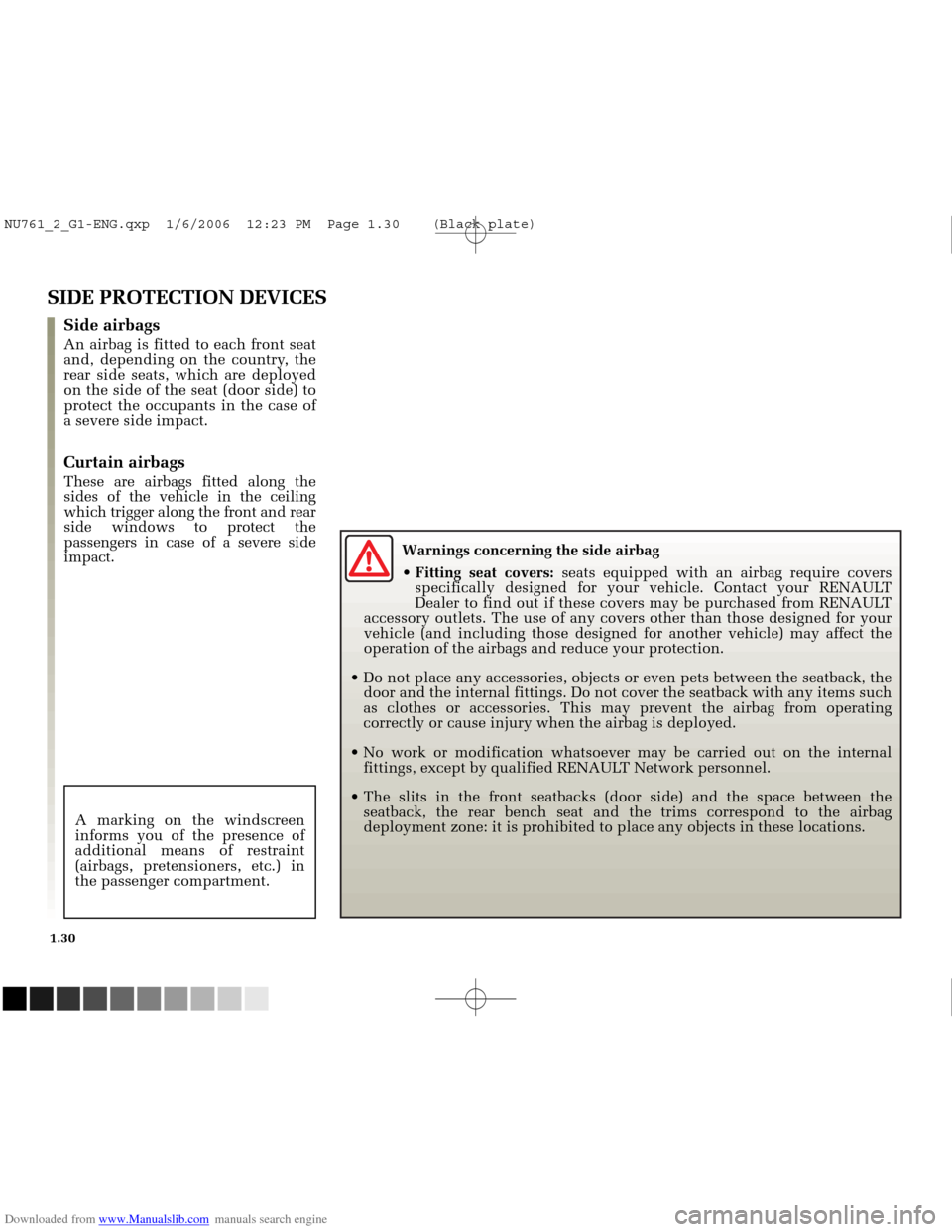
Downloaded from www.Manualslib.com manuals search engine
NU761_2_G1-FRA.qxd 10/11/05 15:53 Page 1.30
1.30
Warnings concerning the side airbag
Fitting seat covers: seats equipped with an airbag require covers
specifically designed for your vehicle. Contact your RENAULT
Dealer to find out if these covers may be purchased from RENAULT
accessory outlets. The use of any covers other than those designed for y\
our
vehicle (and including those designed for another vehicle) may affect \
the
operation of the airbags and reduce your protection.
Do not place any accessories, objects or even pets between the seatback,\
the door and the internal fittings. Do not cover the seatback with any items\
such
as clothes or accessories. This may prevent the airbag from operating
correctly or cause injury when the airbag is deployed.
No work or modification whatsoever may be carried out on the internal fittings, except by qualified RENAULT Network personnel.
The slits in the front seatbacks (door side) and the space between the\
seatback, the rear bench seat and the trims correspond to the airbag
deployment zone: it is prohibited to place any objects in these location\
s.
SIDE PROTECTION DEVICES
Side airbags
An airbag is fitted to each front seat
and, depending on the country, the
rear side seats, which are deployed
on the side of the seat (door side) to
protect the occupants in the case of
a severe side impact.
Curtain airbags
These are airbags fitted along the
sides of the vehicle in the ceiling
which trigger along the front and rear
side windows to protect the
passengers in case of a severe side
impact.
A marking on the windscreen
informs you of the presence of
additional means of restraint
(airbags, pretensioners, etc.) in
the passenger compartment.
NU761_2_G1-ENG.qxp 1/6/2006 12:23 PM Page 1.30 (Black plate)